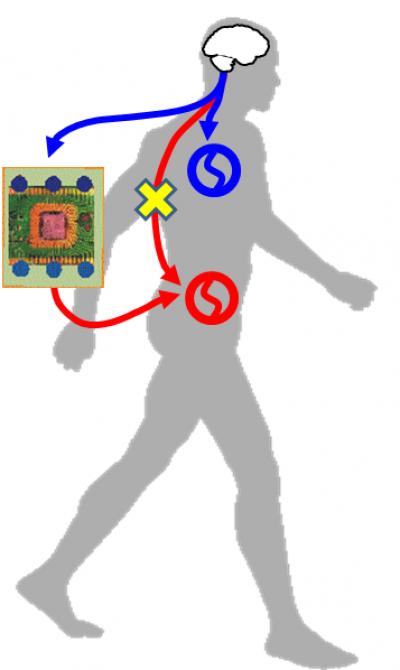Scientists bypass spinal column non-invasively to trigger walking
August 18, 2014

The illustration shows how a computer can connects the brain directly to the locomotion center in the spine via a magnetic device (credit: Yukio Nishimura)
Japanese researchers have created an “artificial neural connection” (ANC) from the brain directly to the spinal locomotion center in the lower thoracic and lumbar regions of the spine, potentially one day allowing patients with spinal-cord damage, such as paraplegics, to walk.
The study led by Shusaku Sasada, research fellow, and Yukio Nishimura, associate professor, both of the National Institutes of Natural Sciences (NINS), was published online in The Journal of Neuroscience on August 13, 2014.
Neural networks called “central pattern generators” (see Ref. 2 and 3 below) in the locomotion center (lower than the lesion site) are capable of producing rhythmic movements, such as walking, even when isolated from the brain, the researchers suggest.
The experiment
The researchers worked with neurologically intact subjects who are were asked to allow the computer to passively control their leg movements.
As a surrogate, the researchers used muscle signals normally generated by the arm movements associated with leg movements. These signals were used to control a computer-driven magnetic device that non-invasively (externally) stimulated neurons in the spinal locomotion center.
Additional simultaneous peripheral electrical stimulation to the foot via the ANC enhanced this walking-like behavior. Kinematics of the induced behaviors were identical to those observed in normal voluntary walking.
The researchers said they are planning clinical studies in the near future.
Abstract of Journal of Neuroscience paper
Gait disturbance in individuals with spinal cord lesion is attributed to the interruption of descending pathways to the spinal locomotor center, whereas neural circuits below and above the lesion maintain their functional capability. An artificial neural connection (ANC), which bridges supraspinal centers and locomotor networks in the lumbar spinal cord beyond the lesion site, may restore the functional impairment. To achieve an ANC that sends descending voluntary commands to the lumbar locomotor center and bypasses the thoracic spinal cord, upper limb muscle activity was converted to magnetic stimuli delivered noninvasively over the lumbar vertebra. Healthy participants were able to initiate and terminate walking-like behavior and to control the step cycle through an ANC controlled by volitional upper limb muscle activity. The walking-like behavior stopped just after the ANC was disconnected from the participants even when the participant continued to swing arms. Furthermore, additional simultaneous peripheral electrical stimulation to the foot via the ANC enhanced this walking-like behavior. Kinematics of the induced behaviors were identical to those observed in voluntary walking. These results demonstrate that the ANC induces volitionally controlled, walking-like behavior of the legs. This paradigm may be able to compensate for the dysfunction of descending pathways by sending commands to the preserved locomotor center at the lumbar spinal cord and may enable individuals with paraplegia to regain volitionally controlled walking.